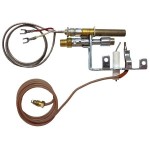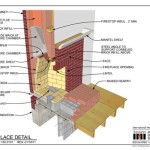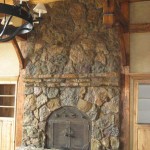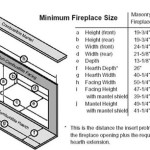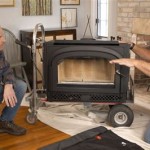Anatomy of a Fireplace
Fireplaces, timeless fixtures in homes, add warmth, ambiance, and a sense of comfort. While their aesthetics are undeniable, understanding the anatomy of a fireplace is essential for safe operation, maintenance, and appreciating their intricate design. This article delves into the key components of a traditional fireplace, exploring their functions and how they contribute to the overall fireplace experience.
Firebox: The Heart of the Fireplace
The firebox is the defining element of any fireplace, serving as the combustion chamber where the fire burns. It is typically constructed from firebrick or cast iron, materials that can withstand extreme temperatures. The firebox is usually lined with refractory mortar to further insulate the surrounding structure and ensure proper heat distribution. The firebox's design influences the fireplace's efficiency and safety, with features like a raised hearth and a proper flue ensuring optimal airflow and smoke removal.
The Hearth: A Foundation for Fire
The hearth, often made of stone, tile, or concrete, provides a solid base for the firebox. It extends outward from the fireplace opening and serves several crucial functions. First, it protects the floor from heat and potential damage. Second, its slightly raised position allows for easier access and a clear view of the fire. Finally, it can be aesthetically integrated with the overall design of the fireplace, adding to its visual appeal.
Flue: The Smoke's Escape Route
The flue is the vertical passageway that carries smoke and combustion gases from the firebox up and out of the chimney. It is typically made of brick, metal, or ceramic, with a smooth, uninterrupted surface to prevent blockages. The flue's draft is crucial for proper combustion, drawing in fresh air to support the fire while expelling harmful gases. Proper flue design, including its height and diameter, directly impacts the fireplace's efficiency and safety.
Damper: Controlling the Fire's Breath
The damper, located within the flue, acts as a valve controlling the airflow. When open, it allows smoke to escape easily, while when closed, it restricts airflow, effectively extinguishing the fire. Dampers can be manual, requiring physical effort, or automatic, controlled by a mechanism that opens and closes based on temperature or other factors. Proper damper operation is essential for safety and efficient combustion.
Mantel: A Decorative and Functional Element
The mantel is the decorative shelf above the fireplace opening. It serves both aesthetic and practical purposes. Often made of wood, stone, or metal, the mantel enhances the visual appeal of the fireplace and complements the overall room design. It also provides a surface for displaying decorative objects, artwork, or even candles. The mantel can be designed with integrated shelves, cupboards, or other functional elements to further enhance its usefulness.
Chimney: The Final Exit for Smoke
The chimney, encompassing the flue and its surrounding structure, serves as the final passageway for smoke and combustion products to exit the home. It is typically built of brick, stone, or metal, and its height is crucial for proper draft. The chimney's design also includes a cap to prevent rain and debris from entering the flue, ensuring safe and efficient operation of the fireplace.
Grates: Supporting the Fire's Embrace
Grates are the metal bars or grids within the firebox that support the burning logs. They create space for air to circulate around the wood, promoting efficient combustion and minimizing smoke production. Grates also prevent ashes from falling onto the hearth, maintaining cleanliness and safety. The design of the grate, including its size, shape, and material, influences the fireplace's efficiency and overall performance.
Andirons: Holding the Fire's Power
Andirons, often crafted from iron, brass, or other durable materials, are decorative supports placed within the firebox. Their primary function is to hold logs in place, ensuring proper airflow and promoting even burning. Andirons enhance the fireplace's aesthetic appeal, adding visual interest and complementing the surrounding design. They come in various styles, materials, and sizes, reflecting the homeowner's taste.
Fireplace Tools: Maintaining the Fire's Essence
A set of fireplace tools, typically housed within a stand or rack, is essential for maintaining the fire. The tools include a poker for rearranging logs, a shovel for removing ashes, and a brush for cleaning the grate and hearth. Proper usage of these tools ensures safe and efficient operation of the fireplace, promoting optimal combustion and minimizing mess.
Embracing the Fireplace's Anatomy
Understanding the anatomy of a fireplace allows for a greater appreciation of its functionality, aiding in its proper operation and maintenance. Recognizing each component's role enhances the overall experience, from starting a fire and enjoying its comforting glow to ensuring safety and longevity. Whether a traditional hearth or a modern fireplace, mastering its intricate workings guarantees a warm and inviting atmosphere for years to come.

Understanding The Anatomy Of A Fireplace Madewell Masonry

What Are The Components Of A Fireplace Five Ways Fires

Chimney Diagram Potomac Services

Fireplace Anatomy Wilkens Contracting Masonry Toronto

Chimney Parts And How They Work 2024 All Pro Service

Chimney System Anatomy Crofton Md Cleansweepaa Com

Fireplace Anatomy

The Complete Anatomy Of A Chimney Chimcare

How It Works Closer To The Hearth

Anatomy Of A Fireplace Devinci Cast Stone Mantels In 2024 Parts Surround
Related Posts

